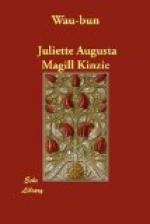The tin cups which were to hold our coffee were duly set around, then breakfast-plates of the same metal, with knives and forks; then followed the viands, among the most conspicuous of which was a large tin pan of boiled ducks.
The Judge, wishing to show, probably, that, although we were in the vast wilderness, all fastidious nicety had not been left behind, took up the plate which had been set before him, and, seeing something adhering to it which did not exactly please him, handed it over his shoulder to Grignon, requesting him to wipe it carefully. Grignon complied by pulling a black silk barcelona handkerchief out of his bosom, where it had been snugly tucked away to answer any occasion that might present itself, and, giving the tin a furious polishing, handed it back again. The Judge looked at it with a smile of approbation, and giving a glance around the table as much as to say, “You see how I choose to have things done,” applied himself to his breakfast.
The trail for Fort Winnebago then led from the shore opposite Butte des Morts, through Ma-zhee-gaw-gaw swamp, and past Green Lake, and it was well for the Judge that his horses stood waiting for him to “mount and away” as early as possible after breakfast, or I am afraid the story I should have been tempted to tell would have made his ride an uncomfortable one throughout the day.
We had hardly finished breakfast when our hunter, who had received the ammunition, returned, bringing with him about fifty fine ducks, which he had shot in little more than an hour. From that time until the close of our journey our supply of these delicate birds was never wanting.
CHAPTER VII.
BUTTE DES MORTS—LAKE PUCKAWAY.
The Butte des Morts, or Hillock of the Dead, was the scene long since[11] of a most sanguinary battle between the French and the Mis-qua-kees, or Foxes. So great was the carnage in this engagement, that the memory of it has been perpetuated by the gloomy appellation given to the mound where the dead were buried. The Foxes up to this time had inhabited the shores of the river to which they had given their name, but, being completely overwhelmed and beaten in this conflict, they retired to the neighborhood of the Mississippi, and sought an asylum among their allies, the Saukies, or, as they are now called, the Sauks, with whom they became gradually incorporated, until the combined tribes came to be known, as at present, by the name of “Sauks and Foxes.”
Among the French inhabitants of the upper country, each tribe of Indians has a particular appellation, descriptive of some peculiarity of either their habits or their personal appearance. Thus, the Chippewas, from their agility, are denominated “Sauteurs,” or Jumpers; the Ottawas, the “Courtes-oreilles,” or Short-ears. The Menomonees, from the wild rice so abundant in their country, are called “Folles Avoines;”—the Winnebagoes, from their custom of wearing the fur of a polecat on their legs when equipped for war, are termed “les Puans;”—the Pottowattamies, from their uncleanly habits, “les Poux;”—the Foxes are “les Renards,” etc. etc.




